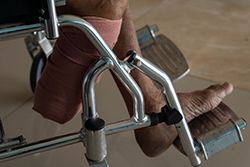Diabetes Awareness
Startling Statistics
 Five-year mortality rates for people with diabetes who undergo below-knee amputation range from 40 to 70 percent—worse than many forms of cancer.
Five-year mortality rates for people with diabetes who undergo below-knee amputation range from 40 to 70 percent—worse than many forms of cancer.
But there is hope. Podiatrists save limbs and lives. Studies have shown that care by a podiatrist significantly lowers the risk of amputation and hospitalization for patients with diabetes and saves on costs for our health-care system.
Podiatrists are on the cutting edge of wound care. These highly trained physicians and surgeons employ surgical techniques and the latest science and technology to heal wounds and save limbs—even when other specialties can’t.
For Patients and Families/Caregivers
Here's what you can do to help prevent amputation.
- Prevention is key! Examine your own feet daily for any changes and keep an appointment with an APMA-member podiatrist at least once a year. Changes in color, temperature, or even hair growth on your feet can be minor signs of a major problem; always contact your podiatrist if you notice a change. If you do not have access to a podiatrist through your health-care system, be sure to ask your general practitioner to check your feet during regular visits.
Manage your A1C and be as active as you can. Controlling your blood sugar helps your body can heal itself. - Remember that wounds can’t wait. Even if it doesn’t seem like a big deal, check in with your podiatrist or another member of your care team if you injure your foot or ankle. Even a simple callus can progress rapidly to a non-healing, limb-threatening wound in a patient with diabetes.
Seek urgent care for a suspected fracture or sprain, any foreign objects in your feet (stepping on a pin or a sliver of broken glass, for example), or an infection. Contact your podiatrist or another member of your diabetes care team for treatment as soon as possible! - Foot care is diabetes care. If you have diabetes, you need to be concerned about your foot and ankle health. Serious complications, leading to systemic infection, amputation, and even death, can start in the feet. Keep a regular appointment with a podiatrist if your health-care coverage allows it, and if not, be sure to ask your primary care provider to check your feet and refer you for care by a podiatrist if needed.
More information for people with diabetes:
- An Overview: What is diabetes? What is a diabetic foot ulcer?
- Diabetic Peripheral Neuropathy: Peripheral neuropathy is loss of sensation in your feet due high or low blood sugar. Learn more in our video!
- Conduct a Daily Foot Exam: APMA Trustee David Alper, DPM, explains how to conduct a simple daily foot exam to help prevent complications.
- Get three simple tips from a podiatrist living with diabetes! Our short video is available in English and Spanish! Read an article from Dr. Santiago, as well.
- Diabetes Footwear and Products: View our Seal-approved products for managing and treating diabetes.
- Learn from Our Experts: APMA Trustee David Alper, DPM, shared his advice with a patient in an interview produced by the American Diabetes Association.
- Join the Conversation: Follow us on X, Facebook, Instagram, and LinkedIn to hear more about topics related to diabetes and foot health year-round.
- Watch: APMA member Paul Han, DPM, MS, appeared on "Viewpoint with Dennis Quaid" to discuss complications of diabetes in the foot.
For APMA Members, Component Societies, and Affiliated Organizations
Individual members and practices can make use of the resources in our digital tool kit to promote their expertise and educate current and prospective patients. These downloadable resources include social media posts, a press release, logos, a tip sheet, and more.
Note: Members in New York should contact NYSPMA for materials customized to your needs. Members who work in a managed care setting can access versions of materials designed for them in the tool kit, as well.
